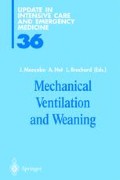Abstract
Mechanical ventilation (MV) is a supportive tool for critically ill patients which saves lives worldwide each day. Nevertheless, this advantage is obtained at the cost of additional morbidity and mortality. The classical side effects of MV are widely recognized in the form of tracheal damage, need for sedatives, and hemodynamic disturbances. In the 1980s, the impact of pulmonary infections, so-called ventilator-associated pneumonia, was the target of substantial research in the field of adverse consequences of MV. In the 1990s, the focus was directed to the direct damage caused by MV on the lungs, and such terms as “barotrauma”,“volotrauma”, and recently “biotrauma” were tailored to define different problems directly related to the use of life-saving MV.
Access this chapter
Tax calculation will be finalised at checkout
Purchases are for personal use only
Preview
Unable to display preview. Download preview PDF.
References
Esteban A, Alfa I, Ibanez J, Benito S, Tobin MJ, Spanish Lung Failure Collaborative Group (1994) Modes of mechanical ventilation and weaning: a national survey of Spanish hospitals. Chest 106: 1188–1193
Esteban A, Anzueto A, Alia I, Gordo F, Azpeteguia C, Palizas F, et al (2000) How is mechanical ventilation employed in the intensive care unit? An international utilization review. Am J Respir Crit Care 161: 1450–1458
Alia I, Esteban A, Gordo F (1998) What have we learned about weaning over the last five years? In: Vincent JL (ed) Yearbook of intensive care and emergency medicine. Springer, Berlin Heidelberg New York, pp 505–516
Mancebo J (1996) Weaning from mechanical ventilation. Eur Respir J 9: 1923–1931
Hebert PC, Wells G, Blajchman MA, Marshall J, Martin C, Pagliarello G, et al (1999) A multicenter, randomized, controlled clinical trial of transfusion requirements in critical care. N Engl J Med 340: 409–417
Coplin WM, Pierson DJ, Cooley KD, Newell DW, Rubenfeld GD (2000) Implications of extubation delay in brain-injured patients meeting standard weaning criteria. Am J Respir Crit Care Med 161: 1530–1536
Aubier M, Murciano D, Lecocguic Y, et al (1985) Effect of hypophosphatemia on diaphragmatic contractility in patients with acute respiratory failure. N Engl J Med 313: 420–424
Aubier M, Viires N, Piquet J, et al (1985) Effects of hypocalcemia on diaphragmatic strength generation. J Appl Physiol 58: 2054–2061
Yanos J, Wood LDH, Davis K, Keamy M (1993) The effect of respiratory and lactic acidosis on diaphragm function. Am Rev Respir Dis 147: 616–619
Murciano D, Boczkowski J, Lecocguic Y, Milic-Emili J, Pariente R, Aubier M (1988) Tracheal occlusion pressure: a simple index to monitor respiratory muscle fatigue during acute respiratory failure in patients with chronic obstructive pulmonary disease. Ann Intern Med 108: 800–805
Laghi F, D’Alfonso N, Tobin MJ (1995) Pattern of recovery from diaphragmatic fatigue over 24 h. J Appl Physiol 79: 539–546
Esteban A, Frutos F, Tobin MJ, Alfa I, Solsona JF, Valverdü I, et al (1995) A comparison of four methods of weaning patients from mechanical ventilation. N Engl J Med 332: 345–50
Jubran A, Tobin MJ (1997) Passive mechanics of lung and chest wall in patients who failed or succeeded in trials of weaning. Am J Respir Crit Care Med 155: 916–921
Jubran A, Tobin MJ (1997) Pathophysiologic basis of acute respiratory distress in patients who fail a trial of weaning from mechanical ventilation. Am J Respir Crit Care Med 155: 906–915
Ely EW, Baker AM, Dunagan DP, et al (1996) Effect on the duration of mechanical ventilation of identifying patients capable of breathing spontaneously. N Engl J Med 335: 1864–1869
Saura P, Blanch Ll, Mestre J, Vallés J, Artigas A, Fernandez R (1996) Clinical consequences of the implementation of a weaning protocol. Intensive Care Med 22: 1052–1056
Thorens JB, Kaelin RM, Jolliet P, Chevrolet JC (1995) Influence of quality of nursing on the duration of weaning from mechanical ventilation in patients with chronic obstructive pulmonary disease. Crit Care Med 23: 1807–1815
Kress JP, Pohlman AS, O’Connor MF, Hall JB (2000) Daily interruption of sedative infusions in critically ill patients undergoing mechanical ventilation. N Engl J Med 342: 1471–1477
Yang KL, Tobin MJ (1991) A prospective study of indexes predicting the outcome of trials of weaning from mechanical ventilation. N Engl J Med 324: 1445–1450
Epstein SK (1995) Etiology of extubation failure and the predictive value of the rapid shallow breathing index. Am J Respir Crit Care Med 152: 545–549
Esteban A, Alia A, Gordo F, Fernandez R, Solsona JF, Vallverdu I, et al (1997) Extubation outcome after spontaneous breathing trials with T-tube or pressure support ventilation. Am J Respir Crit Care Med 156: 459–465
Tobin MJ (2000) Weaning from mechanical ventilation: what have we learned? Respir Care 45: 417–431
Editor information
Editors and Affiliations
Rights and permissions
Copyright information
© 2003 Springer-Verlag Berlin Heidelberg
About this paper
Cite this paper
Fernandez, R. (2003). Timing and Criteria for Beginning Weaning. In: Mancebo, J., Net, A., Brochard, L. (eds) Mechanical Ventilation and Weaning. Update in Intensive Care Medicine, vol 36. Springer, Berlin, Heidelberg. https://doi.org/10.1007/978-3-642-56112-2_16
Download citation
DOI: https://doi.org/10.1007/978-3-642-56112-2_16
Publisher Name: Springer, Berlin, Heidelberg
Print ISBN: 978-3-540-44181-6
Online ISBN: 978-3-642-56112-2
eBook Packages: Springer Book Archive

